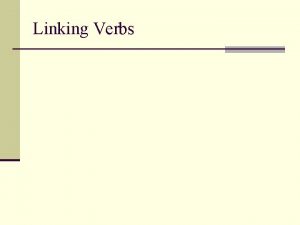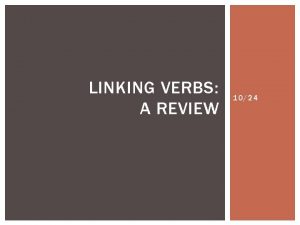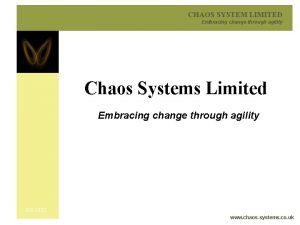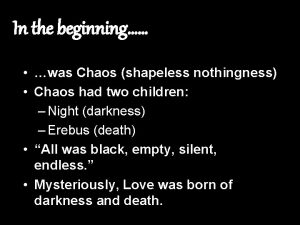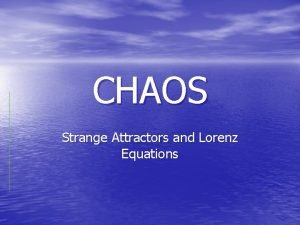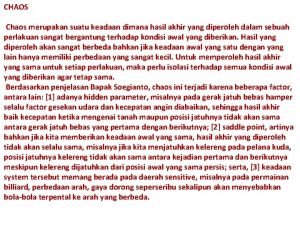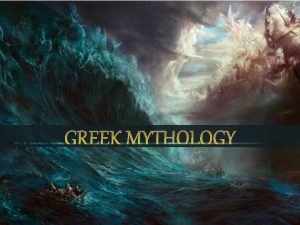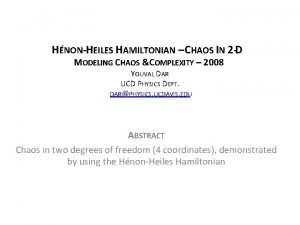Chaos Linking Chaos in the Model to Chaos










- Slides: 10

Chaos Linking Chaos in the Model to Chaos in the Brain Kaolin Fire – http: //erif. org

A quick look at Neurons • Real neurons have inputs (dendrites) and outputs (via the axon) • When a neuron’s inputs are strong enough, it is : likely: to “fire” (fits a poisson distribution) http: //www. lebenswissen. de/pix/b+t/sciences_street/08_hirnforschung/neuron. jpg

And artificial neurons… 1/(1+e^-z) • a. k. a. a “perceptron” • Have artificial inputs and outputs; typically either real-valued or binary • “fire” in a wholly artificial manner, usually with a step or sigmoid function

The typical artificial Neural Network • • Is “feed-forward” Displays no recursion Has no chaos Can still do some amazing things • Training and learning is very artificial; • Hebbian learning vs. standard “forgetful” (palimpsest) learning

The typical biological neural network • Is hideously complex • Displays elements of chaotic behavior • Olfactory bulb, LGN, auditory areas… http: //www. interchange. ubc. ca/neurosci/faculty/images/thm/ast_red. jpg

The magic of Three • Elements of regularity • Elements of oneness • Elements of unpredictability … Period 3 implies Chaos But what does that mean, in the brain?

Chaos in the brain • The brain is constantly active, at least to some baseline • Many iterative/recursive processes • As noted, firing tends to fit a poisson distribution • Intimations of low-dimensional chaotic behavior (power-law statistical voodoo) • Strange attractors (memories/pattern recognition) • May even be a factor in the primeval evolution of language, along with synesthesia http: //www. colantonio. net/brain 12. jpg

Chaos in an artificial neural network? • RNN – recurring neural network • Chaos proven in a simple “sigmoid”-activated perceptron pair [through the doubling map] • Chaotic palimpsest learning functions much better than nonchaotic (can learn 5 x as much!) • But… But what does that mean, to the brain? http: //citeseer. nj. nec. com/cache/papers/cs/1359/http: z. Szwww. usc. eduz. Szhscz. Szlab_apkz. Szarchivesz. Szchaos. pdf/wang 91 perioddoublings. pdf

Modeling chaos in the brain Two approaches; take das blinkenlights (the two-perceptron pair) and: • Threshold the sigmoid to only “fire” above a certain time, using an arbitrary clock • Fast-forward and treat the value as the time between spikes, normalized against some reasonable (biologically valid) range

So where does that leave us? With plenty to read • http: //erif. org/chaos/fire 03 chaosbrain. pdf • http: //tentacle. net/wiki/Chaos. And. The. Brain/ And plenty to do • Current research in hearing aids and other prostheses • Better models make better experiments Any Questions?












